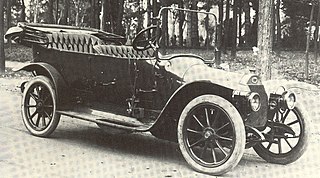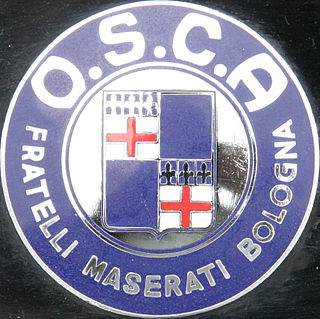
The Fiat Tipo is a compact car, designed by the I.DE.A Institute design house, and produced by the Italian manufacturer Fiat between 1988 and 1995.

The Ferrari Testarossa is a 12-cylinder mid-engine sports car manufactured by Ferrari, which went into production in 1984 as the successor to the Ferrari Berlinetta Boxer. The Pininfarina-designed car was originally produced from 1984 until 1991, with two model revisions following the end of Testarossa production called the 512 TR and F512 M, which were produced from 1992 until 1996. Including revised variations, almost 10,000 cars in total were produced, making it one of the most mass-produced Ferrari models.

The Fiat Tempra is a small family car produced by the Italian automaker Fiat from 1990 to 1996 in Italy. The Tempra was intended as a replacement for the Fiat Regata. The original project was called Tipo 3, being a mid size car between the Fiat Tipo and the bigger Fiat Croma. The Tempra shares its Type Three platform with the Lancia Dedra and Alfa Romeo 155.

The Fiat Punto is a supermini car produced by the Italian manufacturer Fiat from 1993 to 2018, spanning over three generations. The third generation of the car was marketed between 2005 and 2009 as the Grande Punto, and between 2009 and 2012 as the Punto Evo, when the single-word Punto name was reintroduced. As of May 2013, nearly nine million units had been sold globally.

The Lancia Thema is an executive car produced by the Italian automaker Lancia between 1984 and 1994, and one of four cars to share the Type Four platform alongside the Alfa Romeo 164, Fiat Croma and Saab 9000. The Thema was first shown in Turin Motor Show in 1984.

The Fiat 600 is a rear-engine, water-cooled city car, manufactured and marketed by Fiat from 1955 to 1969 — offered in two-door fastback sedan and four-door Multipla mini MPV body styles.

The Fiat 1100 is a small family car produced from 1953 to 1969 by the Italian manufacturer Fiat. It was an all-new unibody replacement for the Fiat 1100 E, which descended from the pre-war, body-on-frame Fiat 508 C Balilla 1100. The 1100 was changed steadily and gradually until being replaced by the new Fiat 128 in 1969. There were also a series of light commercial versions of the 1100 built, with later models called the Fiat 1100T, which remained in production until 1971. The Fiat 1100 D also found a long life in India, where Premier Automobiles continued to build the car until the end of 2000.

The Lancia Fulvia is an automobile produced by Lancia between 1963 and 1976. Named after Via Fulvia, the Roman road leading from Tortona to Turin, it was introduced at the Geneva Motor Show in 1963 and manufactured in three variants: Berlina 4-door saloon, 2-door Coupé, and Sport, an alternative fastback coupé designed and built by Zagato on the Coupé floorpan.

The Lancia Flavia is an executive car produced by Lancia in Italy from 1961 to 1971. Production continued as the Lancia 2000 from 1971 to 1975.

The Lancia Rally was a mid-engine sports car and rally car built by Lancia in the early 1980s to compete in the FIA Group B World Rally Championship. Driven by Markku Alén, Attilio Bettega, and Walter Röhrl, the car won Lancia the manufacturers' world championship in the 1983 season. It was the last rear-wheel drive car to win the WRC.

The Fiat 124 Sport Coupé is a two-door, four-seater notchback coupé produced by the Italian automaker Fiat in three generations between 1967 and 1975. It was based on the Fiat 124 saloon.

Itala was a car manufacturer based in Turin, Italy, from 1904 to 1934, started by Matteo Ceirano and five partners in 1903.

The Fiat Zero, known also as the Fiat 12/15 hp, was a car produced by FIAT from 1912 to 1915. At launch it sold for 8,000 lire, which later was reduced to 6,900 lire, the equivalent of 23,250 € in 2003. It was equipped with a 1.8-liter, 18 PS (13.2 kW) engine that achieved about 19.6 miles per gallon and could reach about 50 mph (80 km/h). It was the first Fiat to sell more than 2,000 similarly bodied units and most of these were four seater bodies. In 1915 production came to an end when the factory was converted for war production.

The 508 Balilla was a compact car designed and developed by Fiat in 1932. It was, effectively, the replacement of the Fiat 509, although production of the earlier model had ceased back in 1929. It had a three-speed transmission, seated four, and had a top speed of about 50 mph (80 km/h). It sold for 10,800 lire. About 113,000 were produced.

The Fiat 850 is a small rear-engine, rear-wheel-drive car manufactured and marketed by Italian car manufacturer Fiat from 1964 to 1973.

O.S.C.A. was an Italian manufacturer of racing and sports cars established 1947 in San Lazzaro di Savena, Bologna, by the Maserati brothers, and closed down in 1967. Its name is usually abbreviated to OSCA or Osca.

The Fiat 518, also called Fiat Ardita, was a model of car produced by Italian car manufacturer Fiat between 1933 and 1938. The name "Ardita" was also used on the six-cylinder engined and more expensive Fiat Ardita 2500 or 527.

The Fiat 519 was a model of car produced by Italian automotive company, Fiat between 1922 and 1927.

In 2015 Spain produced 2.7 million cars which made it the 8th largest automobile producer country in the world and the 2nd largest car manufacturer in Europe after Germany. The forecast as of 2016 was to produce a total of 2.8 million vehicles from which about 80% is for export. During the first half of 2016, with exports valued over 24 billion euros over that period, the automotive industry accounted for 18.9% of the total Spanish exports.

The Fiat S76, later also known as Fiat 300 HP Record and nicknamed "The Beast of Turin", was a car built in 1910 by the Italian company Fiat specifically to beat the land speed record held in those years by the Blitzen Benz. Its 28,353 cc displacement engine delivered 290 hp. Only two examples were built.





















